Finite Element Analysis of a Novel Approach for Knee and Ankle Protection during Landing
Abstract
1. Introduction
2. Materials and Methods
2.1. Model Construction
2.2. Material Properties and Interactions
2.3. Boundary and Loading Conditions
2.4. Data Analysis
3. Results
3.1. Validation
3.2. Ankle Protection
3.3. Knee Protection
4. Discussion
5. Conclusions
- (1)
- By absorbing some of the impact energy that would otherwise be experienced by the human body, the semi-rigid support at the ankle joint could reduce the peak stress on the inferior articular surface of the tibia and the horizontal force on the talus, thus, reducing the risk of ankle injury.
- (2)
- Additionally, the decreasing impact force on the lower extremity due to the semi-rigid support at the ankle joint could also reduce the stress peak of the menisci and articular cartilages in the knee joint.
- (3)
- Notably, as a function of the retractive force generated by the spring component at the knee joint, it could distribute the load in a better way such that the stress distribution and contact area between the menisci and articular cartilages were more equally distributed.
Author Contributions
Funding
Institutional Review Board Statement
Informed Consent Statement
Acknowledgments
Conflicts of Interest
References
- Hanzlíková, I.; Richards, J.; Hébert-Losier, K.; Smékal, D. The effect of proprioceptive knee bracing on knee stability after anterior cruciate ligament reconstruction. Gait Posture 2019, 67, 242–247. [Google Scholar] [CrossRef]
- Bricknell, M.C.M.; Craig, S.C. Military parachuting injuries: A literature review. Occup. Med. 1999, 49, 17–26. [Google Scholar] [CrossRef] [PubMed]
- Yungchien, C.; Sell, T.C.; Abt, J.P.; Takashi, N.; Jennifer, D.; Mark, M.G.; Rusty, R.; Brian, S.; Lephart, S.M. Air assault soldiers demonstrate more dangerous landing biomechanics when visual input is removed. Mil. Med. 2012, 177, 41–47. [Google Scholar]
- Liebermann, D.G.; Hoffman, J.R. Timing of preparatory landing responses as a function of availability of optic flow in-formation. J. Electromyogr. Kinesiol. 2005, 15, 120–130. [Google Scholar] [CrossRef] [PubMed]
- Jiang, T.; Tian, S.; Fan, X.; Chen, T.; Luo, C.; Yao, J.; Wang, L. Kinematics and kinetics of lower-extremity joints in parachuting landing with backpack and knee brace. Med. Eng. Phys. 2020, 86, 1–7. [Google Scholar] [CrossRef]
- Ekeland, A. Injuries in military parachuting: A prospective study of 4499 jumps. Injury 1997, 28, 219–222. [Google Scholar] [CrossRef]
- Wong, D.W.-C.; Niu, W.; Wang, Y.; Zhang, M. Finite Element Analysis of Foot and Ankle Impact Injury: Risk Evaluation of Calcaneus and Talus Fracture. PLoS ONE 2016, 11, e0154435. [Google Scholar] [CrossRef] [PubMed]
- Wu, D.; Zheng, C.; Wu, J.; Wang, L.; Wei, X.; Wang, L. Protective Knee Braces and the Biomechanics of the Half-Squat Parachute Landing. Aerosp. Med. Hum. Perform. 2018, 89, 26–31. [Google Scholar] [CrossRef] [PubMed]
- Herscovici, D.; Scaduto, J.M. Management of High-Energy Foot and Ankle Injuries in the Geriatric Population. Geriatr. Orthop. Surg. Rehabil. 2012, 3, 33–44. [Google Scholar] [CrossRef] [PubMed]
- Ihmels, W.D.; Seymore, K.D.; Brown, T.N. Effect of Sex and Ankle Brace Design on Knee Biomechanics During a Single-Leg Cut. Am. J. Sports Med. 2020, 48, 1496–1504. [Google Scholar] [CrossRef]
- Hangalur, G.; Brenneman, E.; Nicholls, M.; Bakker, R.; Laing, A.; Chandrashekar, N. Can a knee brace reduce the strain in the anterior cruciate ligament? A study using combined in vivo/in vitro method. Prosthetics Orthot. Int. 2016, 40, 394–399. [Google Scholar] [CrossRef]
- Sinclair, J.K.; Selfe, J.; Taylor, P.J.; Shore, H.F.; Richards, J.D. Influence of a knee brace intervention on perceived pain and patellofemoral loading in recreational athletes. Clin. Biomech. 2016, 37, 7–12. [Google Scholar] [CrossRef]
- Hanzlíková, I.; Richards, J.; Tomsa, M.; Chohan, A.; May, K.; Smékal, D.; Selfe, J. The effect of proprioceptive knee bracing on knee stability during three different sport related movement tasks in healthy subjects and the implications to the man-agement of Anterior Cruciate Ligament (ACL) injuries. Gait Posture 2016, 48, 165–170. [Google Scholar] [CrossRef]
- Gudibanda, A.; Wang, Y. Effect of the Ankle Stabilizing Orthosis on Foot and Ankle Kinematics During Cutting Maneuvers. Res. Sports Med. 2005, 13, 111–126. [Google Scholar] [CrossRef]
- Stoffel, K.K.; Nicholls, R.L.; Winata, A.R.; Dempsey, A.R.; Boyle, J.J.W.; Lloyd, D.G. Effect of Ankle Taping on Knee and Ankle Joint Biomechanics in Sporting Tasks. Med. Sci. Sports Exerc. 2010, 42, 2089–2097. [Google Scholar] [CrossRef]
- Zhang, S.; Wortley, M.; Chen, Q.; Freedman, J. Efficacy of an Ankle Brace with a Subtalar Locking System in Inversion Control in Dynamic Movements. J. Orthop. Sports Phys. Ther. 2009, 39, 875–883. [Google Scholar] [CrossRef]
- Bot, S.D.M.; Mechelen, W.V. The Effect of Ankle Bracing on Athletic Performance. Sports Med. 1999, 27, 171–178. [Google Scholar] [CrossRef]
- Mason-Mackay, A.R.; Whatman, C.; Reid, D.; Lorimer, A. The effect of ankle bracing on landing biomechanics in female netballers. Phys. Ther. Sport 2016, 20, 13–18. [Google Scholar] [CrossRef]
- Wu, X.; Pei, B.; Pei, Y.; Hao, Y.; Zhou, K.; Wang, W. Comprehensive Biomechanism of Impact Resistance in the Cat’s Paw Pad. BioMed Res. Int. 2019, 2019, 31467873. [Google Scholar] [CrossRef] [PubMed]
- Wu, X.; Pei, B.; Pei, Y.; Wang, W.; Hao, Y.; Zhou, K. How do Cats Resist Landing Injury: Insights into the Multi-level Buffering Mechanism. J. Bionic Eng. 2020, 17, 600–610. [Google Scholar] [CrossRef]
- Athanasiou, K.A.; Liu, G.T.; Lavery, L.A.; Lanctot, D.R.; Schenck, R.C. Biomechanical Topography of Human Articular Cartilage in the First Metatarsophalangeal Joint. Clin. Orthop. Relat. Res. 1998, 348, 269–281. [Google Scholar] [CrossRef]
- Siegler, S.; Block, J.; Schneck, C.D. The Mechanical Characteristics of the Collateral Ligaments of the Human Ankle Joint. Foot Ankle 1988, 8, 234–242. [Google Scholar] [CrossRef] [PubMed]
- Wang, Y.; Li, Z.; Wong, W.C.; Cheng, C.K.; Zhang, M. Finite element analysis of biomechanical effects of total ankle ar-throplasty on the foot. J. Orthop. Transl. 2018, 12, 55–65. [Google Scholar]
- Cheung, T.M.; Zhang, M.; Leung, K.L.; Fan, Y.B. Three-dimensional finite element analysis of the foot during standing—A material sensitivity study. J. Biomech. 2005, 38, 1045–1054. [Google Scholar] [CrossRef] [PubMed]
- Anderson, D.D.; Goldsworthy, J.K.; Li, W.; Rudert, M.J.; Tochigi, Y.; Brown, T.D. Physical validation of a patient-specific contact finite element model of the ankle. J. Biomech. 2007, 40, 1662–1669. [Google Scholar] [CrossRef] [PubMed]
- Li, G.; Gil, J.; Kanamori, A.; Woo, S.L.-Y. A Validated Three-Dimensional Computational Model of a Human Knee Joint. J. Biomech. Eng. 1999, 121, 657–662. [Google Scholar] [CrossRef]
- Li, Y.; Wu, J.; Zheng, C.; Huang, R.R.; Na, Y.; Yang, F.; Wang, Z.; Wu, D. The Effect of Landing Surface on the Plantar Kinetics of Chinese Paratroopers Using Half-Squat Landing. J. Sports Sci. Med. 2013, 12, 409–413. [Google Scholar]
- Huang, H.-Y.; Teng, T.-L.; Liang, C.-C. Lower Extremity Injuries of Volleyball Players During Moving Spike Landing. Am. J. Sports Sci. 2016, 4, 10. [Google Scholar] [CrossRef][Green Version]
- Song, Y.; Debski, R.E.; Musahl, V.; Maribeth, T.; Woo, S.L.-Y. A three-dimensional finite element model of the human anterior cruciate ligament: A computational analysis with experimental validation—ScienceDirect. J. Biomech. 2004, 37, 383–390. [Google Scholar] [CrossRef]
- Li, G.; Suggs, J.; Gill, T. The Effect of Anterior Cruciate Ligament Injury on Knee Joint Function under a Simulated Muscle Load: A Three-Dimensional Computational Simulation. Ann. Biomed. Eng. 2002, 30, 713–720. [Google Scholar] [CrossRef]
- Niu, W.; Feng, T.; Jiang, C.; Zhang, M. Peak vertical ground reaction force during two-leg landing: A systematic review and mathematical modeling. BioMed Res. Int. 2014, 2014, 126860. [Google Scholar] [CrossRef] [PubMed]
- Winter, D.A. Biomechanics and Motor Control of Human Movement, 4th ed.; Wiley: Hoboken, NJ, USA, 2009. [Google Scholar]
- Forman, J.L.; Lopez-Valdes, F.J.; Duprey, S.; Bose, D.; de Dios, E.d.P.; Subit, D.; Gillispie, T.; Crandall, J.R.; Segui-Gomez, M. The tolerance of the human body to automobile collision impact—A systematic review of injury biomechanics research, 1990–2009. Accid. Anal. Prev. 2015, 80, 7–17. [Google Scholar] [CrossRef] [PubMed]
- Funk, J.R.; Crandall, J.R.; Tourret, L.J.; MacMahon, C.B.; Bass, C.R.; Patrie, J.T.; Khaewpong, N.; Eppinger, R.H. The Axial Injury Tolerance of the Human Foot/Ankle Complex and the Effect of Achilles Tension. J. Biomech. Eng. 2002, 124, 750–757. [Google Scholar] [CrossRef]
- Nalla, R.K.; Stölken, J.; Kinney, J.H.; Ritchie, R.O. Fracture in human cortical bone: Local fracture criteria and toughening mechanisms. J. Biomech. 2005, 38, 1517–1525. [Google Scholar] [CrossRef]
- Refshauge, K.M.; Raymond, J.; Kilbreath, S.L.; Pengel, L.; Heijnen, I. The Effect of Ankle Taping on Detection of Inversion-Eversion Movements in Participants with Recurrent Ankle Sprain. Am. J. Sports Med. 2009, 37, 371–375. [Google Scholar] [CrossRef] [PubMed]
- Johnson, K.A. Anatomy of the Foot and Ankle: Descriptive, Topographic, Functional. Mayo Clin. Proc. 1984, 59, 289. [Google Scholar] [CrossRef]
- Knapik, J.J.; Spiess, A.; Swedler, D.I.; Grier, T.L.; Darakjy, S.S.; Jones, B.H. Systematic Review of the Parachute Ankle Brace. Am. J. Prev. Med. 2010, 38, S182–S188. [Google Scholar] [CrossRef]
- Wu, D.; Zheng, C.; Wu, J.; Hu, T.; Huang, R.; Wang, L.; Fan, Y. Prophylactic Ankle Braces and the Kinematics and Kinetics of Half-Squat Parachute Landing. Aerosp. Med. Hum. Perform. 2018, 89, 141–146. [Google Scholar] [CrossRef]
- Niu, W.; Wang, Y.; He, Y.; Fan, Y.; Zhao, Q. Biomechanical Gender Differences of the Ankle Joint During Simulated Half-Squat Parachute Landing. Aviat. Space Environ. Med. 2010, 81, 761–767. [Google Scholar] [CrossRef]
- Amoroso, P.J.; Bell, N.S.; Jones, B.H. Injury among female and male army parachutists. Aviat. Space Environ. Med. 1997, 68, 1006–1011. [Google Scholar]
- Amamilo, S.C.; Samuel, A.W.; Hesketh, K.T.; Moynihan, F.J. A prospective study of parachute in-juries in civilians. J. Bone Jt. Surg. 1987, 69, 17–19. [Google Scholar] [CrossRef]
- Rishiraj, N.; Taunton, J.E.; Lloyd-Smith, R.; Regan, W.; Niven, B.; Woollard, R. Functional knee brace use effect on peak vertical ground reaction forces during drop jump landing. Knee Surg. Sports Traumatol. Arthrosc. 2012, 20, 2405–2412. [Google Scholar] [CrossRef]
- Jones, R.K.; Chapman, G.J.; Findlow, A.H.; Forsythe, L.; Parkes, M.J.; Sultan, J.; Felson, D.T. A New Approach to Prevention of Knee Osteoarthritis: Reducing Medial Load in the Contralateral Knee. J. Rheumatol. 2013, 40, 309–315. [Google Scholar] [CrossRef]
- Liu, X.; Zhang, M. Redistribution of knee stress using laterally wedged insole intervention: Finite element analysis of knee–ankle–foot complex. Clin. Biomech. 2013, 28, 61–67. [Google Scholar] [CrossRef]
- Wu, X.; Pei, B.; Pei, Y.; Wu, N.; Zhou, K.; Hao, Y.; Wang, W. Contributions of Limb Joints to Energy Absorption during Landing in Cats. Appl. Bionics Biomech. 2019, 2019, 3815612–3815613. [Google Scholar] [CrossRef]
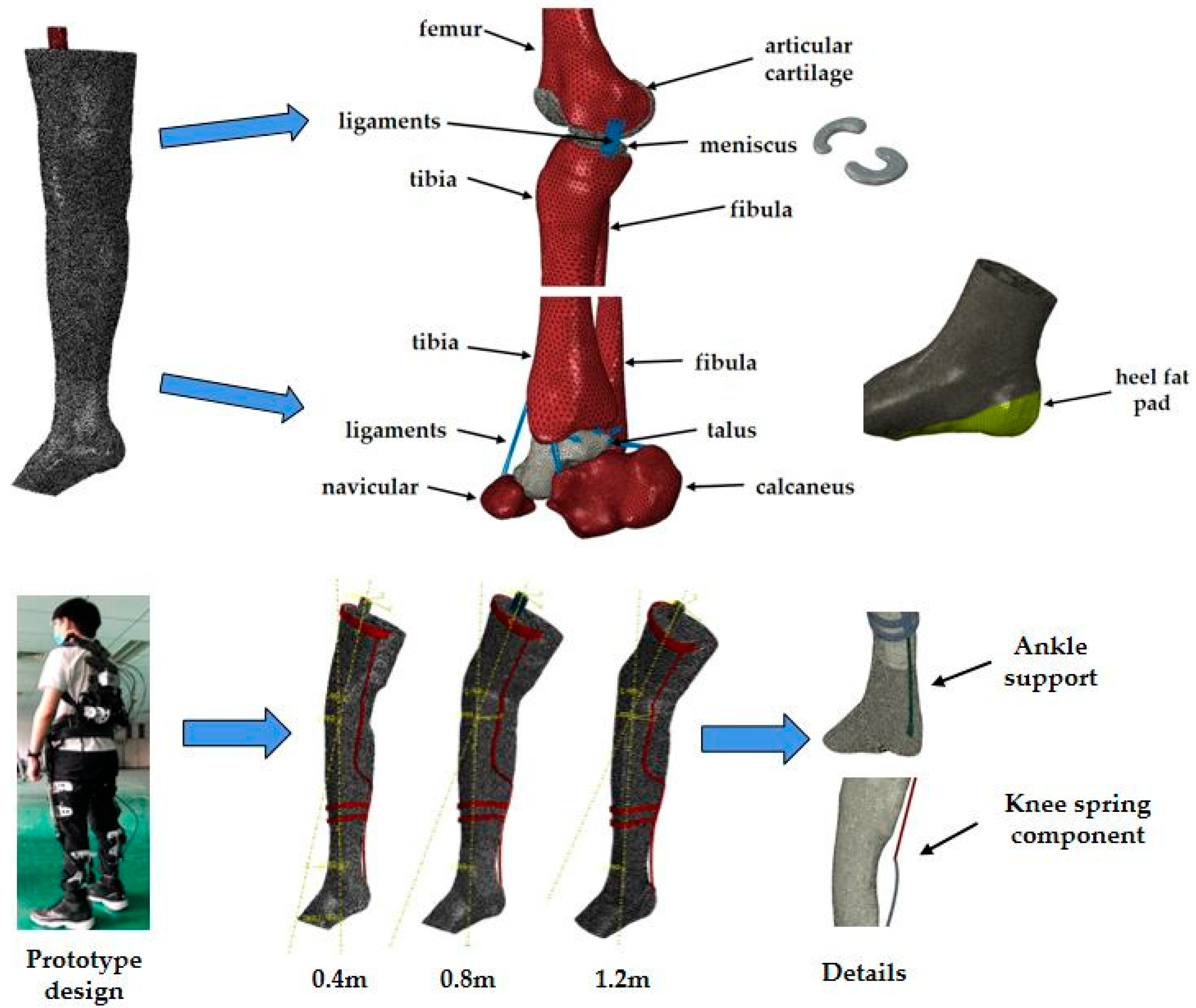
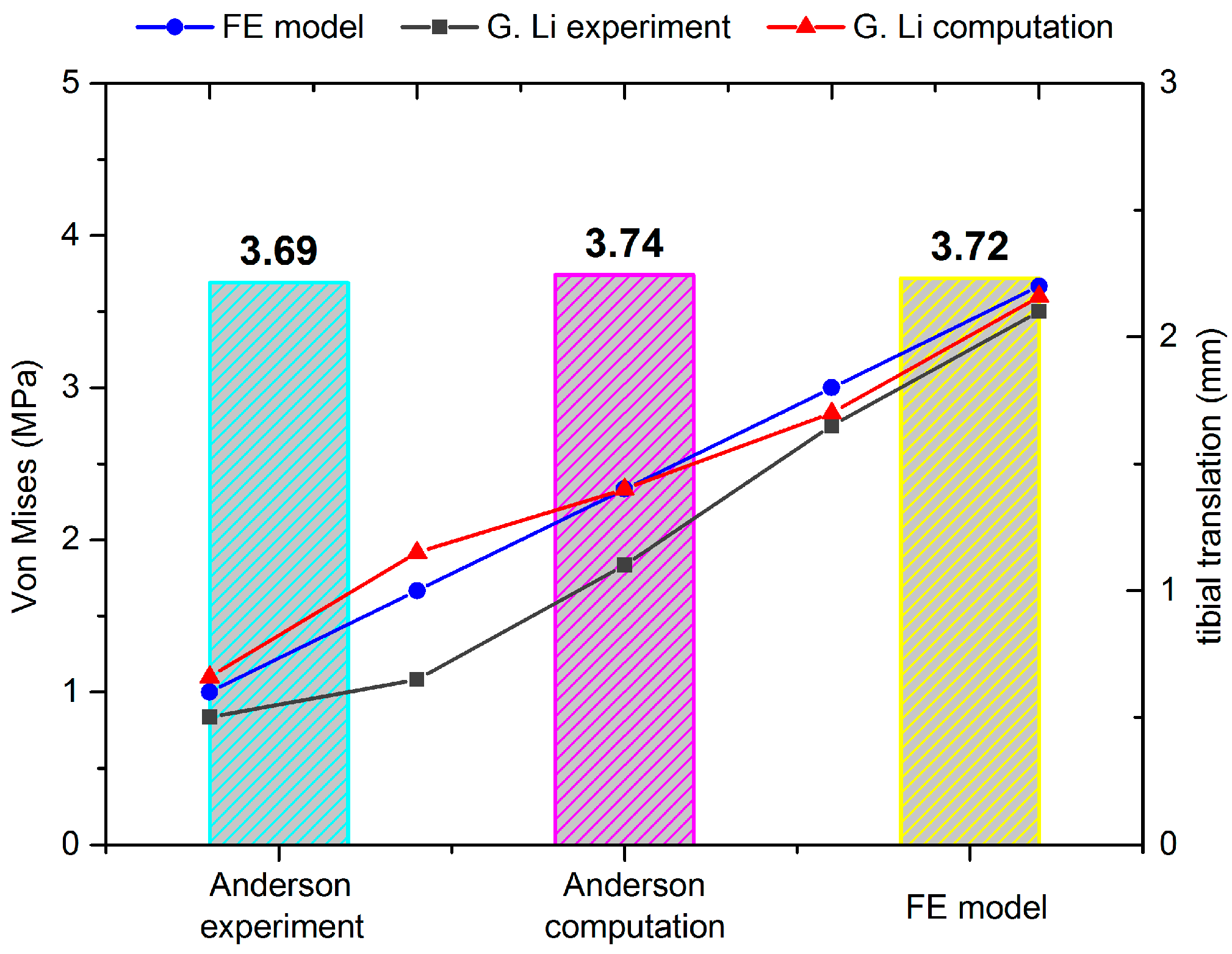
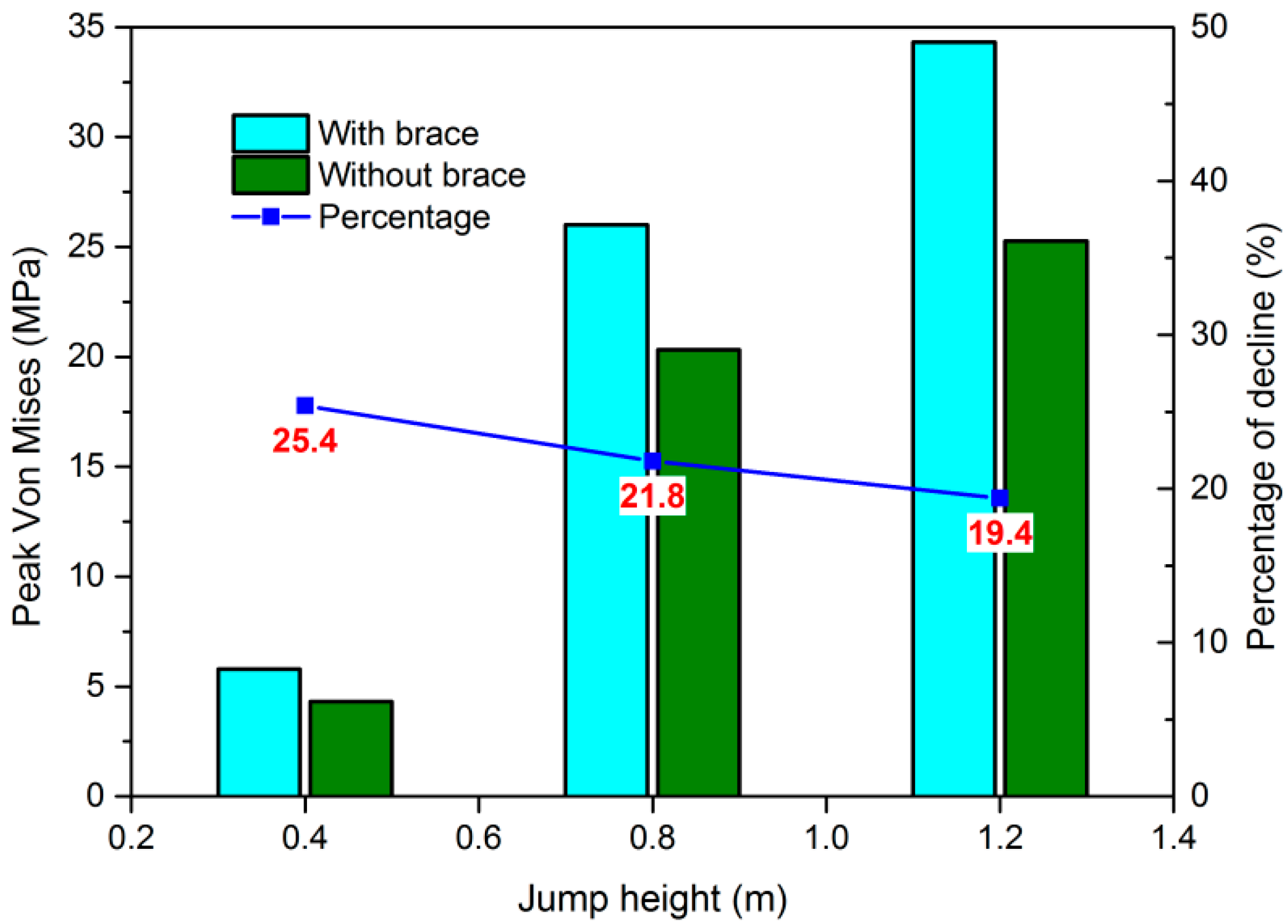
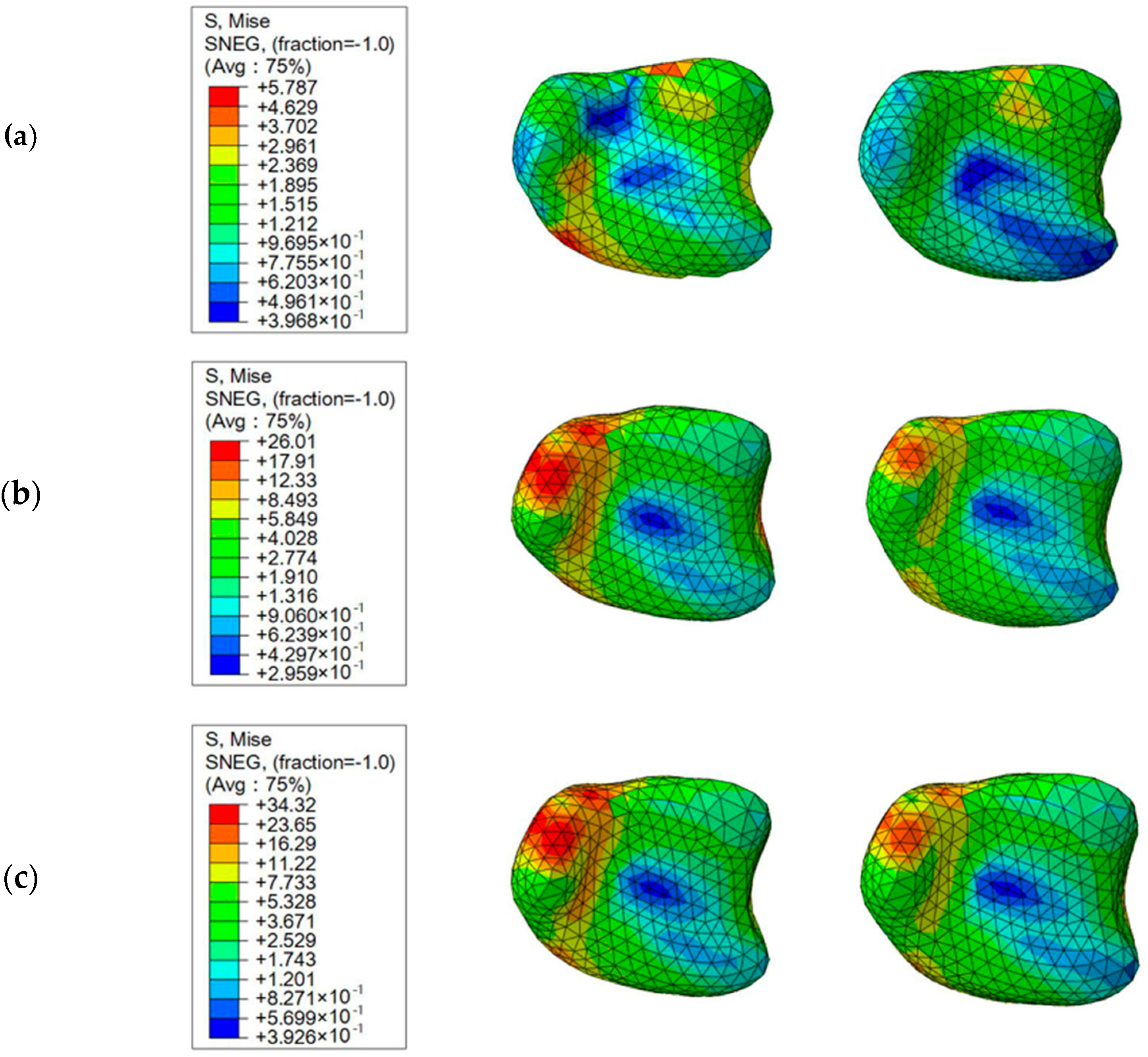
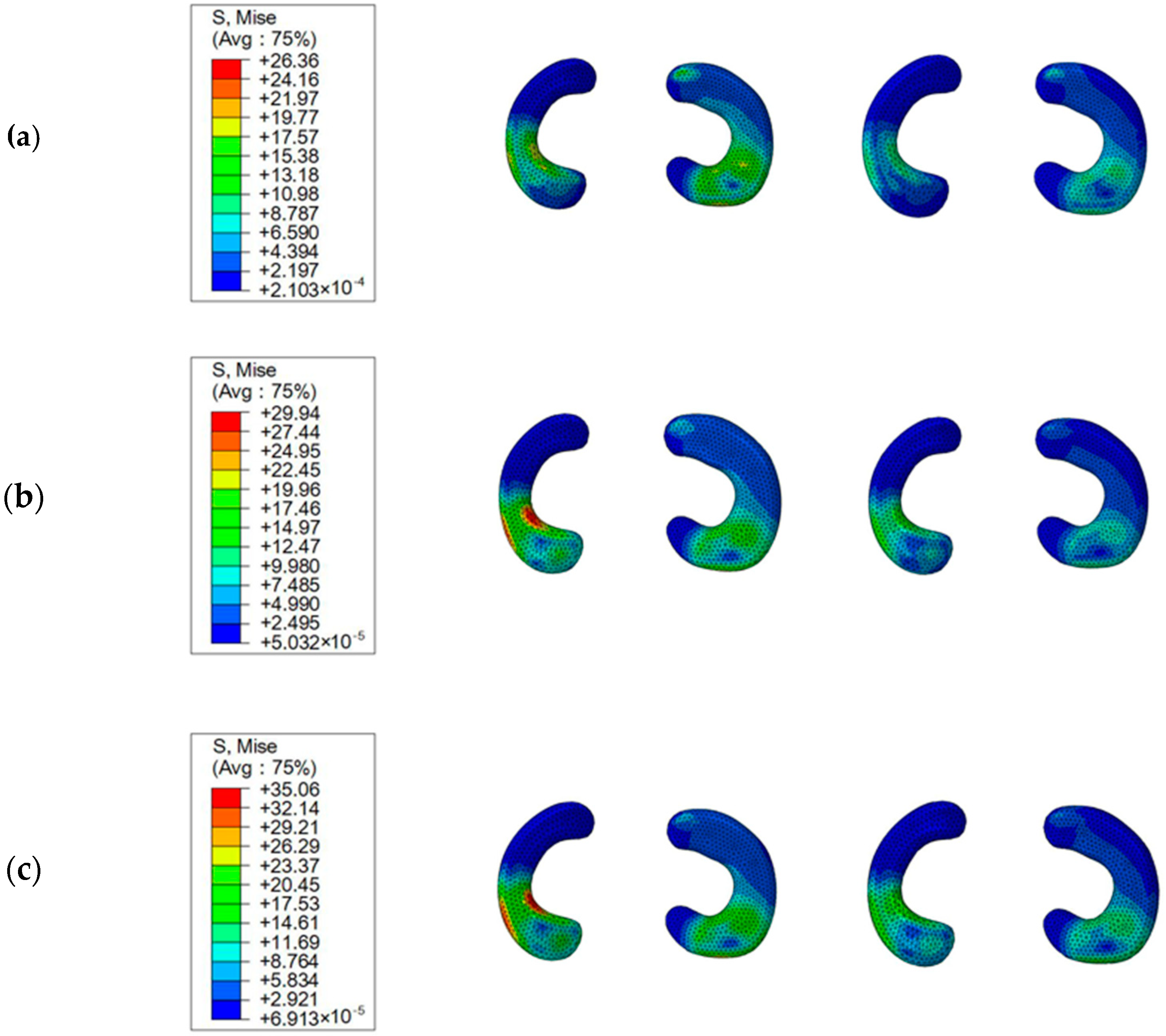
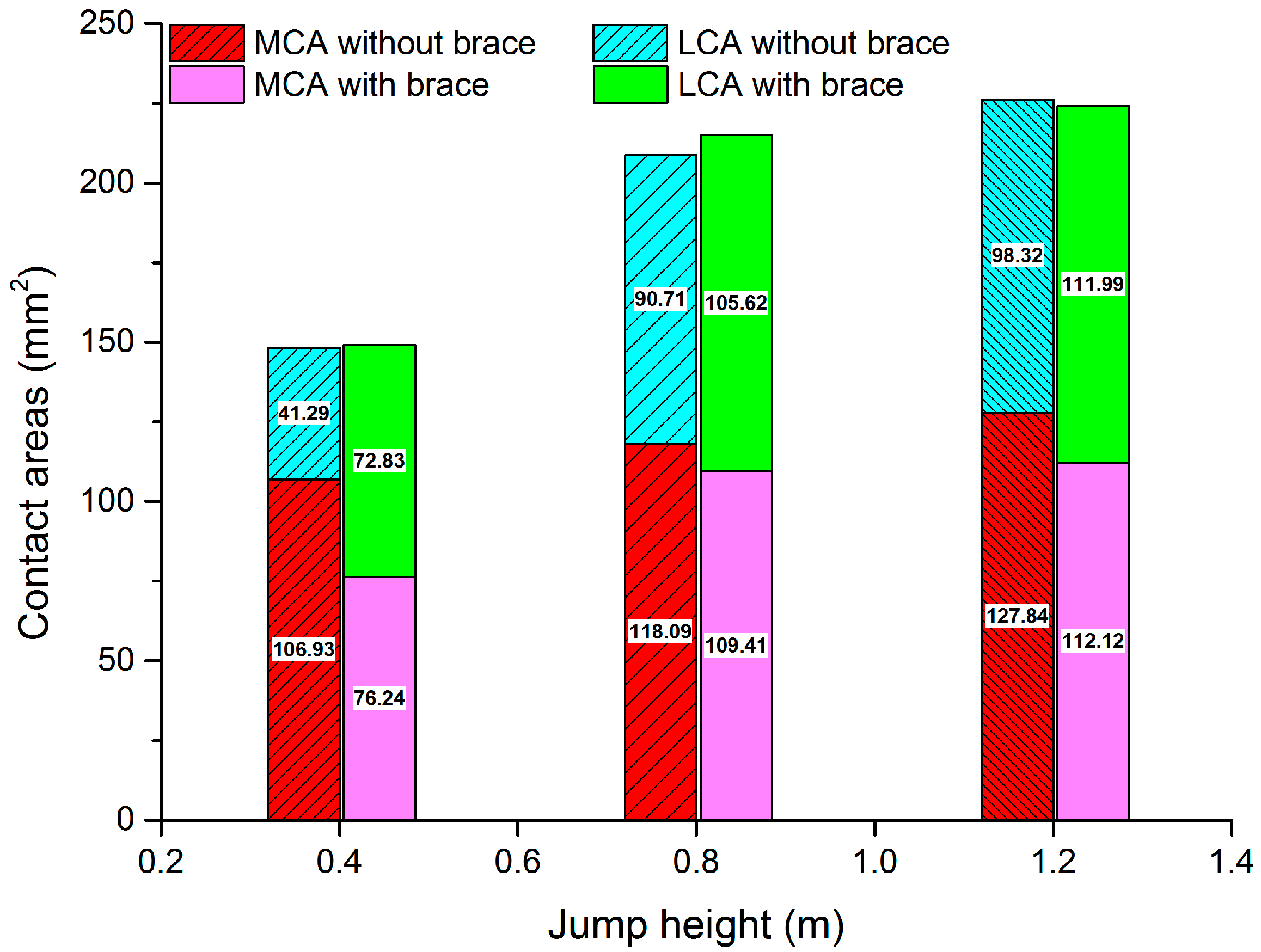
| Height (m) | Horizontal Force with Brace (N) | Horizontal Force without Brace (N) | Percentage Decline |
|---|---|---|---|
| 0.4 | 210.77 | 143.24 | 32% |
| 0.8 | 270.91 | 196.82 | 27.4% |
| 1.2 | 347.45 | 251.87 | 27.5% |
| Height (m) | Part Instances | Peak Von Mises Stress with Brace (MPa) | Peak Von Mises Stress without Brace (MPa) | Percentage Decline |
|---|---|---|---|---|
| 0.4 | Menisci | 26.36 | 20.08 | 23.8% |
| Articular cartilages | 6.018 | 4.85 | 19.4% | |
| 0.8 | Menisci | 29.94 | 23.51 | 21.5% |
| Articular cartilages | 17.41 | 14.94 | 14.2% | |
| 1.2 | Menisci | 35.06 | 30.22 | 13.8% |
| Articular cartilages | 21.07 | 19.15 | 9.1% |
Publisher’s Note: MDPI stays neutral with regard to jurisdictional claims in published maps and institutional affiliations. |
© 2021 by the authors. Licensee MDPI, Basel, Switzerland. This article is an open access article distributed under the terms and conditions of the Creative Commons Attribution (CC BY) license (http://creativecommons.org/licenses/by/4.0/).
Share and Cite
Wu, X.; Pei, B.; Wang, W.; Lu, D.; Guo, L.; He, P. Finite Element Analysis of a Novel Approach for Knee and Ankle Protection during Landing. Appl. Sci. 2021, 11, 1912. https://doi.org/10.3390/app11041912
Wu X, Pei B, Wang W, Lu D, Guo L, He P. Finite Element Analysis of a Novel Approach for Knee and Ankle Protection during Landing. Applied Sciences. 2021; 11(4):1912. https://doi.org/10.3390/app11041912
Chicago/Turabian StyleWu, Xueqing, Baoqing Pei, Wei Wang, Da Lu, Lei Guo, and Peiyan He. 2021. "Finite Element Analysis of a Novel Approach for Knee and Ankle Protection during Landing" Applied Sciences 11, no. 4: 1912. https://doi.org/10.3390/app11041912
APA StyleWu, X., Pei, B., Wang, W., Lu, D., Guo, L., & He, P. (2021). Finite Element Analysis of a Novel Approach for Knee and Ankle Protection during Landing. Applied Sciences, 11(4), 1912. https://doi.org/10.3390/app11041912





